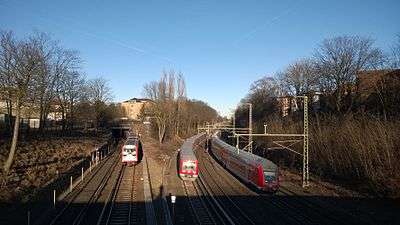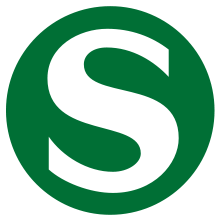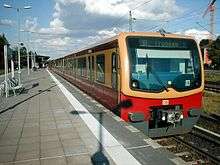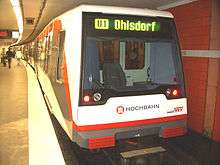Rapid transit in Germany



Rapid transit in Germany consists of five U-Bahn systems and fourteen S-Bahn systems. The U-Bahn or Untergrundbahn (underground railway) are conventional rapid transit systems that run mostly underground, while the S-Bahn or Stadtschnellbahn (city rapid railway) are hybrids of rapid transit and commuter rail that run underground in the city centers and above ground in the suburbs. There are also eighteen premetro or Stadtbahn systems that are rapid transit in the city center and light rail outside.
The U-Bahn consists of five systems: in Berlin, Frankfurt (only line U4), Hamburg, Munich and Nuremberg; these are all run by the transit authorities in the city.
The thirteen S-Bahn systems are in Berlin, Dresden, Hamburg, Hanover, Magdeburg, Mitteldeutschland, Munich, Nuremberg, Rhein-Main, Rhein-Neckar, Rhein-Ruhr (parts thereof also trademarked as Rhein-Sieg and/or Cologne), Rostock and Stuttgart. The S-Bahn systems are all franchised to the incumbent train operating company Deutsche Bahn, and have developed from the mainline railways. Normal headway is 20 minutes and use dedicated tracks running alongside mainline routes. Ticketing is governed by the local transport authority (Verkehrsverbund) and connectivity is integrated into the city public transport system.
History

S-Bahn
In 1882, the growing number of steam-powered trains around Berlin prompted the Prussian State Railways to construct separate rail tracks for suburban traffic. The Berliner Stadtbahn connected Berlin's eight intercity rail stations which were spread throughout the city. A lower rate for the newly founded Berliner Stadt-, Ring- und Vorortbahn (Berlin City, Circular and Suburban Rail) was introduced on 1 October 1891. This rate and the growing succession of trains made the short-distance service stand out from other railroads. The second suburban railroad was the Hamburg-Altonaer Stadt- und Vorortbahn connecting Hamburg with Altona and Blankenese. The Altona office of the Prussian State Railroad established the steam powered railroad in 1906.
The beginning of the 20th century saw the first electric trains, which operated at 15,000 V on overhead lines. As the steam powered trains came to be nuisances to more and more people, the Berliner Stadt-, Ring- und Vorortbahn switched to direct current wagons running on 750 V from a third rail. In 1924, the first electrified route went into service. The third rail was chosen because it made both the modifications of the rail tracks (especially in tunnels and under bridges) and the side-by-side use of electric and steam trains easier. To set it apart from its competitor, the subterranean U-Bahn, the term S-Bahn replaced Stadt-, Ring- und Vorortbahn in 1930.
The Hamburg service had established an experimental alternating current line in 1907. The whole network still used steam power until 1940, when the old locomotives were replaced by 1200 V DC electric ones. In 1934, the Hamburg-Altonaer Stadt- und Vorortbahn was renamed as S-Bahn.

U-Bahn
The term U-Bahn (![]() ) was created at the beginning of the 20th century in Berlin, where the Hochbahngesellschaft (elevated railway company), operating elevated and suburban lines, decided they required an equally short and memorable name for their system as the S-Bahn, and chose to call it U-Bahn (with the U standing for Untergrund, German for Underground). The name was soon adopted for Hamburg's city-owned independent mass transit tram lines.
) was created at the beginning of the 20th century in Berlin, where the Hochbahngesellschaft (elevated railway company), operating elevated and suburban lines, decided they required an equally short and memorable name for their system as the S-Bahn, and chose to call it U-Bahn (with the U standing for Untergrund, German for Underground). The name was soon adopted for Hamburg's city-owned independent mass transit tram lines.
As the post-World War II rebuilding led to wealth and prosperity in West Germany, a modal shift towards travel by car motivated many larger city councils to plan the replacement of the tramways that were seen as a hindrance to car traffic with U-Bahn systems and bus routes. Nuremberg and Munich decided on a full U-Bahn (like those in Berlin and Hamburg) independent from their existing tramways, which were originally planned to be phased out but are now being expanded again. Stuttgart, Frankfurt, Cologne, Bonn, Düsseldorf, Duisburg, Bochum, Essen, Dortmund, Gelsenkirchen, Herne, Mülheim an der Ruhr, Hanover and Bielefeld started to build tunnels for their existing trams, rebuilding tram lines underground. Those systems of tram in tunnels in city centre areas do not meet the criteria of a metro; they are instead light rail systems. Nonetheless, they are sometimes referred to as U-Bahn. Officially, they are called Stadtbahn ("city railways") or U-Stadtbahn.
During the 1990s, when, according to original planning, the tramways of Nuremberg and Munich were scheduled to disappear, a reorientation process set in. Shortage of money, increased passenger numbers and the insight that larger streets only attract even more cars slowed the building of rapid transit lines and led to a renaissance of the tramways in those cities that had forgotten them. In Nuremberg and Munich, after 30 years new rolling stock was purchased, existing lines were modernised, and new ones were built, leading to new integrated traffic concepts. Today, Berlin, Munich and Nuremberg not only have buses, but also trams, S-Bahn, and U-Bahn systems, each with non-shared tracks and different vehicles.
Ticketing
Contrary to practice in most countries, rapid transit in Germany is generally not controlled by faregates, and instead operates on a proof-of-payment system. Plainclothes fare inspectors (Fahrkartenkontrolleure) randomly check passengers for tickets and can issue a fine (of 60 EUR by the rule, as per 2016,) to those who do not have one.
Systems

U-Bahn systems
- Berlin (Berlin U-Bahn, see also: Berlin S-Bahn)
- Frankfurt (Frankfurt U-Bahn, see also: Rhine-Main S-Bahn) (but meets only light rail criteria except line U4)
- Hamburg (Hamburg U-Bahn, see also: Hamburg S-Bahn)
- Munich (Munich U-Bahn, see also: Munich S-Bahn)
- Nuremberg (Nuremberg U-Bahn, see also: Nuremberg S-Bahn)
S-Bahn systems
- Berlin S-Bahn
- Bremen S-Bahn
- Dresden S-Bahn
- Hamburg S-Bahn
- Hanover S-Bahn
- Magdeburg S-Bahn
- Mitteldeutschland S-Bahn (Leipzig / Halle (Saale))
- Munich S-Bahn
- Nuremberg S-Bahn
- Rhine-Main S-Bahn ( Frankfurt / Offenbach / Mainz / Wiesbaden / Darmstadt)
- Rhine-Neckar S-Bahn (Ludwigshafen / Mannheim / Heidelberg / Karlsruhe)
- Rhine-Ruhr S-Bahn (Ruhr Area / Düsseldorf / Cologne (Köln) / Bonn)
- Rostock S-Bahn
- Stuttgart S-Bahn
External links
- Berlin: Berliner Verkehrsgesellschaft
- Frankfurt: Verkehrsgesellschaft Frankfurt
- Hamburg: Hamburger Hochbahn AG
- Munich: Münchner Verkehrsgesellschaft
- Nuremberg: Verkehrs-Aktiengesellschaft Nürnberg